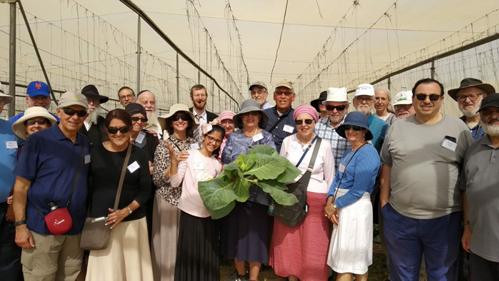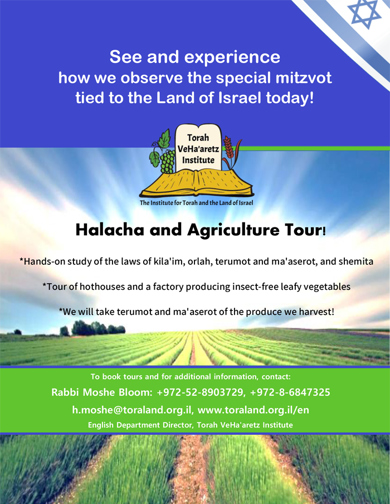
Sivan 5779, Issue no. 8
News
Flyer of Tours at Torah VeHa'aretz Institute
Tours of the Institute
Last month we held two big tours: one for a group from Beit Shemesh, the 55 Plus Anglo Program, Matnas Meyerhoff. The second was for a group from the OU Jerusalem.
Here we learned about orlah, kila'im, terumot and ma'aserot, and about the projects by Torah VeHa'aretz Institute that help practically implement these mitzvot:
- Kashrut supervision for a nursery for orlah and kilaim
- Beit HaOtzar, which facilitates separation of terumot and ma'aserot in a mehudar manner
- Calculating orlah years
- Defining intermediate plants as trees or vegetables
- Listing the scion-rootstock combinations for kilei ilan (grafting)
- Listing various herbs and classifying them as vegetables or trees vis-à-vis kila'im
Afterwards, we toured the experimental plot onsite.
We continued on to the Chasalat-Alei Katif factory, and after a hearty lunch we saw how insect-free leafy vegetables are manufactured. We finished the day with a tour of the Chasalat-Alei Katif hothouses, and saw how cabbage is grown there.

Shavuot
Shavuot marks the beginning of the period when bikurim can be brought to the Beit HaMikdash. For more on bikurim, see the second part of the articles on parashat Devarim and parashat Ki Tisa.
Halachic Guide: Grafting
The prohibition against kilei ilan includes planting seeds of two different species together and sustaining (watering, fertilizing, etc.) trees grafted in a forbidden manner. Those who want to purchase trees for their gardens need to know the right questions to ask in the nursery so that they do not transgress the prohibition against sustaining kilei ilan.
To this end, we prepared an abridged halachic guide on the topic, featuring a comprehensive list of all of the available rootstock-scion combinations (in Israel), classified by halachic category. See here.
Article
The connection between Shavuot, Megillat Rut, and Harvest / Rabbi Yoel Friedemann
Tractate Sofrim states (14:3): "For Rut, Shir HaShirim, Kohelet, Eicha, and Megillat Esther, one has to make a blessing, and to recite [a blessing] on the reading of the scroll, even though it is written in the Scriptures."
The Maharil (Hilchot Shavuot) describes the prevalent custom of the Jewish communities at the time: "Megillat Rut is read on the second day [of the holiday] and each individual recites a blessing on the reading of the scroll (al mikra megilla)." The Abudarham (at the end of Mussaf on Pesach) cites two reasons for this custom: "So too, on the festival of Shavuot it was customary to read Rut (1) because it is written (Rut 1:22) 'At the beginning of the barley harvest' and this is the time of the harvest. (2) Another reason is because our forefathers only received the Torah and entered the covenant after circumcision, immersion, and hartza'at damim (the sprinkling of blood from the convert's offering) … and Rut also converted, as it is stated (Rut 1:16) 'For wherever you go, I will go.'"
The second reason mentioned above is understandable, since there is a clear, substantial connection between Shavuot and Megillat Rut: our national character traits are embodied by Rut and the process of our redemption from Egypt parallels Rut's journey to Judaism. Rut arrives at the conclusion "For wherever you go, I will go; wherever you lodge, I will lodge; your people shall be my people, and your G-d, my G-d" (ibid.). The same is true for the Jewish People when they wholeheartedly decide to accept the Torah, out of free will, and cling to G-d: "And they said: All that the L-rd has commanded we will faithfully do" (Shemot 24:7).
The first reason cited by the Abudarham (as well as the Radbaz 6:2091) seems quite strange. Is the fact that both events – the giving of the Torah and Megillat Rut – took place at the same time of year, at the beginning of the barley harvest, so important that it justifies reading Megillat Rut on Shavuot?
For the full article in English, see here.

